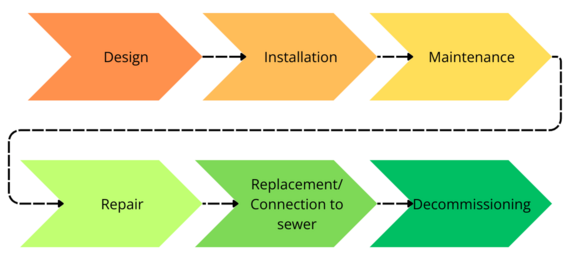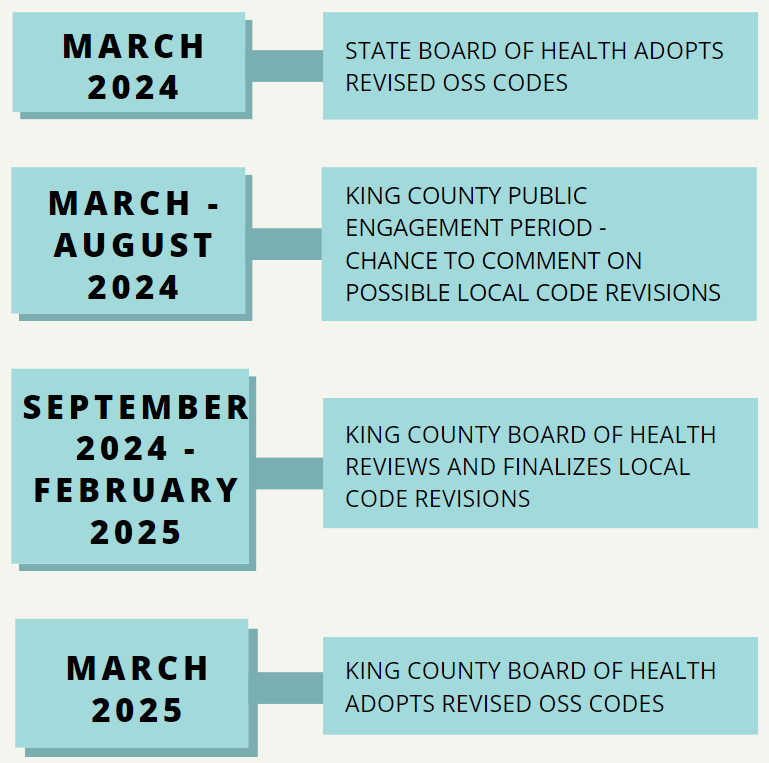|
Happy February! We're back with another edition of the King County On-Site Sewage System (OSS) code revision newsletter. As a reminder, one of our program's top priorities this year is revising the King County OSS codes. Earlier this month, the Washington State Board of Health voted to adopt revised OSS codes, which we expect to be finalized next month. After that, King County will begin a process to adopt revised codes that comply with the state's changes.
Each month, we'll share the latest developments and key OSS information. This month, we're reviewing the life cycle of an OSS, from design to decommissioning, and the key topic areas of local OSS codes. In the coming months, we plan to start our public engagement period, where you'll have an opportunity to give feedback on local OSS codes and potential changes.
We'd like your feedback on this newsletter! We want to know what's working, what isn't, and if it'd be helpful to translate all or part of it. Please take our quick survey about this newsletter to let us know what you think.
Also, you can read last month's newsletter online. We've started an archive section at the bottom of this newsletter so you can access past issues.
As always, if you have any questions, please don't hesitate to reach out.
Sincerely,
Lynn Schneider, RS | OSS Program Supervisor
206.477.2124 | lynn.schneider@kingcounty.gov
Lara Brezina, RS | Interim OSS Operation & Maintenance Program Supervisor
206.477.1764 | lbrezina@kingcounty.gov

An OSS (on-site sewage system, also known as a septic system) treats wastewater for buildings that are not connected to public sewer systems. By properly managing an OSS, you can extend its life span. Knowing the OSS life cycle can help you do just that. The cycle involves design, installation, maintenance, repair, replacement (or connection to sewer), and decommissioning.
 Design: When an OSS is needed to replace an existing one or for new development, a licensed OSS designer or professional engineer designs a system to provide the most effective wastewater treatment. They take into account many factors, including lot size, ground slope, soil conditions, and size of home or occupancy.
Installation: Once Public Health approves the design, we issue an installation permit to a certified Master Installer. The installer works with the designer to install a new system and cover it with soil. After installation, you should only be able to see green riser lids, a control panel, and sometimes a blower if your system uses aeration to treat bacteria.
Note: Designing, installing, and maintaining OSS is complex work that requires a thorough understanding of soil conditions, water flow physics, and microbiology. OSS designers must be licensed by Washington State, and installers, maintainers, and pumpers are certified through King County. Only these individuals are legally authorized to work on your OSS. (Some exceptions apply for gravity OSS.)
Maintenance: Once it’s installed, the property owner is responsible for maintaining the OSS. Have your OSS inspected regularly by a certified OSS maintainer and pumped regularly by a certified pumper/hauler. These educational resources have more information about what you can do to help it run smoothly.
Repair: Sometimes, a component of your OSS will break or not work properly. You’ll need to work with a certified Master Installer, designer, or professional engineer to repair or reconfigure the system.
Replacement (or connection to sewer): All OSS have a limited lifespan and will fail at some point, usually after 30-50 years of use. In many cases, when this happens, you’ll decommission the old system and put in a new one. This includes installing a new drainfield in the reserve area that was set aside for this purpose when the original OSS was installed.
Alternatively, the property can connect to a sewer system (if one is available) by working with a local sewer district.
Decommissioning: When your OSS reaches the end of its lifespan, you will decommission, or “abandon” it. This involves:
- A certified pumper removing the waste in the tank.
- Removing or destroying the lid.
- Filling the tank with soil or gravel.
- Finally, reporting the abandonment to Public Health.
This information will help your system last longer and save you from a “poopy wastewater” nightmare!
King County’s rules for OSS (On-site sewage systems, also known as septic systems) are set by the Board of Health. These rules, also called codes, are laid out in Title 13 of the King County Board of Health regulations. Title 13 has six key areas:
-
Committees: King County is required to organize a Technical Advisory Committee (TAC). The TAC gives input on local regulations, policies, and program processes. Title 13 also requires the County to have a Sewage Review Committee to evaluate appeals about OSS designs.
-
Certifications: King County certifies OSS installers, maintainers, and liquid waste pumper/haulers. Title 13 specifies requirements to obtain and keep these certifications.
-
Land development: There are specific requirements for creating a subdivision or boundary line adjustment when the properties are on OSS. Title 13 also specifies when a property must connect to sewer, in accordance with the Growth Management Act.
-
Design specifications: The State of Washington sets minimum standards for septic system codes. The design section of Title 13 makes sure these minimums are met and includes other standards that address specific King County issues. For instance, some of these other standards address commercial shellfish harvesting adjacent to homes that use septic systems. Shellfish from some King County beaches are harvested and served raw in restaurants all over the world, making these regulations critical to supporting food safety and the economy.
-
Repairs & remodeling: The OSS code establishes permitting requirements for repairing a broken septic system. Title 13 explains how to make sure an OSS supports any remodels or additions to a property.
-
Operation & maintenance: Finally, Title 13 specifies what is needed to keep an OSS functioning well over its entire lifespan. The King County Local Management Plan goes into more detail about how King County can support residents in making sure that OSS are not causing health concerns or polluting local waters.
In the coming months, we'll share more details about each of these six key topics.
Each month, we'll define key terms to know about septic systems.
|
OSS (On-site Sewage System, also known as a septic system)
|
A system of components, located on or nearby the property it serves, that conveys, stores, treats, and/or provides underground treatment and dispersal of sewage. It consists of a collection system (pipes), a treatment component (septic tank), and a soil dispersal component (drainfield).
|
|
Lot size
|
The square footage of a legal parcel of land which is bounded by the property lines of the lot. The state and King County have requirements for how small a lot can be to ensure there is enough room for the house and the OSS.
|
|
Ground slope
|
The change in height of the surface of the ground. If there are large changes in height on a lot, it can affect the way water moves through the soil and change what kind of OSS can be installed.
|
|
Soil conditions
|
The characteristics of the soil including things like the size of the soil particles, presence of groundwater or rock layers, and whether the soil is native or was brought from another site. These conditions will determine the way water moves through the soil and what kind of OSS can be installed.
|
|
Subdivision
|
A division of land into multiple lots, tracts, or parcels.
|
|
Boundary Line Adjustment
|
Redrawing or moving the boundary between existing lots (not creating new lots).
|
|
Septic Inspection
|
A thorough review of all components of a septic system. This should be done on a set schedule depending on the type of OSS - usually every 6 months to 3 years - and when a home is sold.
|
|
Septic Pumping
|
To remove sewage from OSS wastewater tanks and transport it to an approved disposal site. Generally, septic tanks fill up with solids faster as more people use the septic system. This means more frequent pumping will be needed with larger households. A pumper will usually do a brief review of the condition of the tank and note any glaring issues.
|
|
Growth Management Act
|
A law, passed by the State Legislature in 1990, that requires some counties and cities to develop a set of policies to guide development, including King County.
|
|
Local Management Plan
|
A plan required by Washington State Board of Health and passed by the King County Board of Health to ensure OSS are adequately maintained to protect public health through minimum standards of operation and maintenance, and repairing failures quickly. The plan requires Public Health to take an inventory of all OSS in the county, identify sensitive areas and establish maintenance needs in those areas, inform homeowners of needed maintenance, and develop procedures for identifying and repairing failing systems.
|
Key steps in the code revision process:

You can read previous OSS Code Revision newsletters by using the links below:
-
January 2024: Newsletter introduction, OSS 101, and what to know about the OSS code revision process.
|